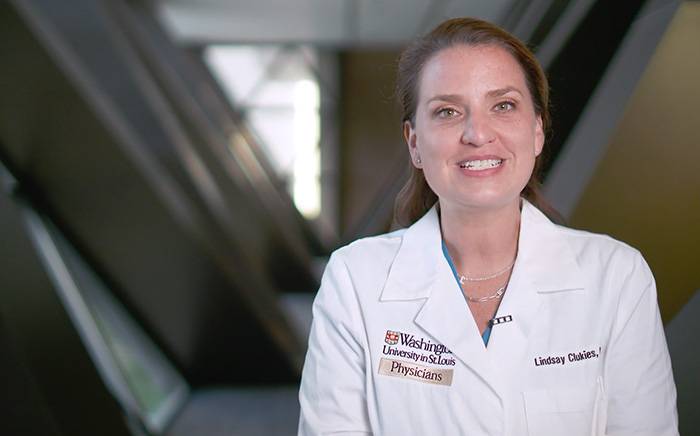
October 7, 2013, 12:00 p.m.
Carolyn Delaney Smith, MD
It is every new parent’s nightmare. Your previously healthy newborn baby turns pale and has difficulty breathing. She is irritable and won’t nurse. By the time you drive to the emergency room, her face looks blue and she won’t wake up.
In the ER, multiple caregivers swarm around her, placing an oxygen mask on her, starting an IV, taking X-rays, and drawing blood. A doctor comes in with an ultrasound machine and begins scanning her chest, frowning as he does so. After what seems an eternity of waiting, the doctor tells you he believes your baby has a serious heart condition and will be transferred to the intensive care unit to be stabilized before undergoing heart surgery sometime in the next few days.
“I don’t understand,” you say slowly, trying to comprehend what has just happened. “When I had the ultrasound during my pregnancy, they said her heart was OK.”
Or, imagine an alternative scenario. As part of normal newborn care, the hospital where your baby was born administers various screening tests: hearing exam, blood test for inherited diseases, and an oxygen saturation test for congenital heart disease. When your baby is a little more than a day old, the pediatrician comes into the room to inform you that your baby’s oxygen level was lower than expected and she will be having an ultrasound of her heart, or echocardiogram.
Later that day, you learn the results: your baby does indeed have a problem with her heart. The doctor informs you that a team of nurses and paramedics from Children’s Hospital is on the way to transfer your baby to the intensive care unit.
“It’s a good thing we discovered this now,” she tells you. “Your baby has a serious condition, but she’s stable.”
Obviously, as new parents, all of us would choose “neither of the above”: we all hope for a perfectly healthy baby. But congenital heart disease is a reality that affects about 2-3 of every 1000 newborns. The development of the heart during the early weeks of pregnancy is a complex process requiring tissues to grow, fold, twist, and attach just so. If something goes wrong, the structures of the heart may not be properly connected, and blood may not be able to flow through the heart normally.
We know some of the risk factors for congenital heart disease: exposure to certain medications or toxins during pregnancy, chromosomal disorders like Down syndrome, and a family history of congenital heart disease. But many babies with heart defects have no risk factors. Screening with ultrasound during pregnancy is an imperfect process; only one-half to two-thirds of congenital heart disease is diagnosed via these ultrasounds. Another 20% of babies may be diagnosed by showing signs while in the newborn nursery, such as a loud or atypical heart murmur, bluish skin color, or a weak pulse in the baby’s legs. So that still leaves about 20% of babies who have a serious heart condition that might go home from the hospital after birth without a diagnosis.
Why does this happen? While in the womb, the baby is still “breathing” through the umbilical cord. There are two connections in the fetal circulation, known as the ductus arteriosus and foramen ovale, which divert blood away from the lungs. When baby takes his first breath after birth, more blood begins flowing to the lungs, but the ductus arteriosus and foramen ovale remain open for a variable amount of time (hours to days). If a baby’s heart is not formed correctly, these connections may literally be lifelines, allowing blood to take a different route through the heart and lungs but still get where it is needed. As these connections close, the baby will develop symptoms from the heart defect, which can occur very rapidly and dramatically: breathing problems, low blood pressure and shock, or even sudden death.
Screening with pulse oximetry is a strategy that pediatricians have developed in recent years to improve our timeliness in diagnosing critical congenital heart disease. The actual test for pulse oximetry screening consists of a nurse or technician measuring the baby’s blood oxygen level with a bandaid-like sensor that is applied to the skin. This test is performed in the baby’s right hand and one of their feet. If the oxygen reading is less than 95%, or if the two numbers don’t match up, the baby will be retested an hour later. If the oxygen level is less than 90%, a doctor or nurse practitioner will see the baby right away and order further testing, including an echocardiogram, or heart ultrasound. The screening is noninvasive and painless and may be performed in the mom’s hospital room.
We started screening all babies with pulse oximetry in the nursery at Barnes-Jewish Hospital in March 2013 and at Progress West Hospital and Missouri Baptist Medical Center in April 2013. Starting in 2014, the screening was required by law in all Missouri hospitals. Although parents have the right to decline the screening, along with other newborn procedures, I would recommend having it done or at least talking with your pediatrician before declining it. The screening gives peace of mind when a normal result is found and could save your baby’s life if a problem is detected.
 Carolyn Delaney Smith, MD
Carolyn Delaney Smith, MD
Carolyn Delaney Smith, MD, is a pediatric hospitalist at St. Louis Children's Hospital, an assistant professor of pediatrics at Washington University School of Medicine, and a guest blogger for MomDocs.









